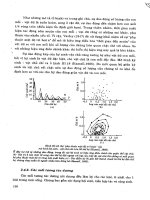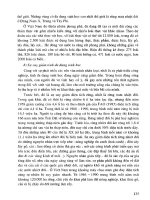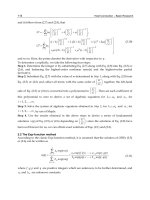McGraw-Hill PDA Robotics 2003 (By.Laxxuss) Part 6 potx
Bạn đang xem bản rút gọn của tài liệu. Xem và tải ngay bản đầy đủ của tài liệu tại đây (251.7 KB, 20 trang )
Typical Optical Transceiver Circuit
The optical transceiver logic can be implemented with discrete com-
ponents for cost savings. Care must be taken in the design and layout
of the photo-detect circuit, due to the small signals that are being
detected and their sensitivity to noise.
MCP2150 Absolute Maximum Ratings
Ambient Temperature under bias . . . . . . . . . . . . . . . . . . . . . . . . . . . . –40°C to +125°C
Storage Temperature. . . . . . . . . . . . . . . . . . . . . . . . . . . . . . . . . . . . . –65°C to +150°C
Voltage on VDD with respect to VSS . . . . . . . . . . . . . . . . . . . . . . . . . . –0.3 V to +6.5 V
Voltage on RESET with respect to VSS . . . . . . . . . . . . . . . . . . . . . . . . . –0.3 V to +14 V
Voltage on all other pins with respect to VSS . . . . . . . . . . . . . . . –0.3 V to (VDD + 0.3 V)
Total Power Dissipation (1). . . . . . . . . . . . . . . . . . . . . . . . . . . . . . . . . . . . . . . 800 mW
Max. Current out of VSS pin . . . . . . . . . . . . . . . . . . . . . . . . . . . . . . . . . . . . . . 300 mA
Max. Current into VDD pin . . . . . . . . . . . . . . . . . . . . . . . . . . . . . . . . . . . . . . . 250 mA
Input Clamp Current, IIK (VI < 0 or VI > VDD) . . . . . . . . . . . . . . . . . . . . . . . . . . ±20 mA
Output Clamp Current, IOK (V0 < 0 or V0 > VDD) . . . . . . . . . . . . . . . . . . . . . . . ±20 mA
Max. Output Current sunk by any Output pin . . . . . . . . . . . . . . . . . . . . . . . . . . . . 25 mA
Max. Output Current sourced by any Output pin. . . . . . . . . . . . . . . . . . . . . . . . . . 25 mA
Note 1: Power Dissipation is calculated as follows:
PDIS = VDD x {IDD - ∑ IOH} + ∑ {(VDD-VOH) x IOH} + ∑(VOL x IOL)
NOTICE: Stresses above those listed under “Maximum Ratings” may
cause permanent damage to the device. This is a stress rating only, and
functional operation of the device at those or any other conditions
above those indicated in the operational listings of this specification
is not implied. Exposure to maximum rating conditions for extended
periods may affect device reliability.
Figure 5.30 shows the physical layout of the MCP2150 chip used in
PDA Robot.
PIC16F876: PDA Robot’s Microcontroller
The PIC16F876 is used to send and receive commands from the robot
to the PDA, get analog readings from the range finder, and switch the
robot’s motors on and off. I chose this chip because it is low cost, very
fast, can be electronically erased, flashed programmed, and is readily
available.
PDA Robotics
78
PDA 05 5/30/03 11:35 AM Page 78
Chapter 5 / The Electronics
79
Figure 5.30
MCP2150 DIP physical dimensions used in PDA Robot.
Units INCHES* MILLIMETERS
Dimension Limits MIN NOM MAX MIN NOM MAX
Number of Pins
Pitch
Top to Seating Plane
Molded Package Thickness
Base to Seating Plane
Shoulder to Shoulder Width
Molded Package Width
Overall Length
Tip 10 Seating Plane
Lead Thickness
Upper Lead Width
Lower Lead Width
Overall Row Spacing §
Mold Draft Angle top
Mold Draft Angle Bottom
.140
.115
.015
.300
.240
.890
.125
.008
.045
.014
.310
5
5
18
.100
.155
.130
.313
.250
.898
.130
.012
.058
.018
.370
10
10
18
2.54
3.94
3.30
7.94
6.35
22.80
3.30
0.29
1.46
0.46
9.40
10
10
.170
.145
.325
.260
.905
.135
.015
.070
.022
.430
15
15
3.56
2.92
.038
7.62
6.10
22.61
3.18
0.20
1.14
0.36
7.87
5
5
4.32
3.68
8.26
6.60
22.99
3.43
0.38
1.78
0.56
10.92
15
15
n
p
A
A2
A1
E
E1
D
L
c
B1
B
eB
␣
ß
* Controlling Parameter
§ Significant Characteristic
Notes:
Dimensions D and E1 do not include mold flash or protrusions. Mold flash or protrusions shall not exceed
.010" (0.254mm) per side.
JEDEC Equivalent: MS-001
Drawing No. C04-007
PDA 05 5/30/03 11:35 AM Page 79
The following information about the specifics of this chip from the
data sheets explains the details of its inner workings. I highly recom-
mend going to www.microchip.com to download any updates. There
is enough information provided in the sheets to write a C or C++ com-
piler for the chip if you are so inclined. When the sheet explains how
the chip does the analog to digital conversions, you could use that
information to create one of your own externally with a capacitor. This
would allow you to buy a chip that has only digital input/output pins
and create the A/D converter yourself. The following summarizes
what you need to know. Features include:
• High-performance RISC CPU
• Only 35 single-word instructions to learn
• All single-cycle instructions except for program branches, which
are two cycle
• Operating speed: DC—20 MHz clock input DC—200 ns instruc-
tion cycle
• Up to 8K ϫ 14 words of FLASH program memory, up to 368 ϫ 8
bytes of data memory (RAM), up to 256 x 8 bytes of EEPROM
data memory
• Pinout compatible to the PIC16C73B/74B/76/77
• Interrupt capability (up to 14 sources)
• Eight-level-deep hardware stack
• Direct, indirect, and relative addressing modes
• Power-on Reset (POR)
• Power-up Timer (PWRT) and Oscillator Start-up Timer (OST)
• Watchdog Timer (WDT) with its own on-chip RC oscillator for
reliable operation
• Programmable code protection
• Power saving SLEEP mode
• Selectable oscillator options
• Low-power, high-speed CMOS FLASH/EEPROM technology
• Fully static design
PDA Robotics
80
PDA 05 5/30/03 11:35 AM Page 80
• In-circuit serial programming (ICSP) via two pins
• Single 5V in-circuit serial programming capability
• In-circuit debugging via two pins
• Processor read/write access to program memory
• Wide operating voltage range: 2.0 V to 5.5 V
• High sink/source current: 25 mA
• Commercial, industrial, and extended temperature ranges
• Low power consumption:
– < 0.6 mA typical @ 3V, 4 MHz
– 20 µA typical @ 3V, 32 kHz
– < 1 µA typical standby current peripheral features:
• Timer0: 8-bit timer/counter with 8-bit prescaler
• Timer1: 16-bit timer/counter with prescaler, can be incremented
during SLEEP via external crystal/clock
• Timer2: 8-bit timer/counter with 8-bit period register, prescaler,
and postscaler
• Two capture, compare, PWM modules
– Capture is 16-bit; max. resolution is 12.5 ns
– Compare is 16-bit; max. resolution is 200 ns
– PWM max. resolution is 10-bit
• 10-bit multi-channel analog-to-digital converter
• Synchronous serial port (SSP) with SPI (master mode) and I to
the power of 2 C (master/slave)
• Universal synchronous asynchronous receiver transmitter
(USART/SCI) with 9-bit address detection
• Parallel slave port (PSP) 8 bits wide, with external RD, WR, and
CS controls (40/44-pin only)
• Brown-out detection circuitry for brown-out reset (BOR)
Figure 5.31 shows the pin layout of the chip.
Chapter 5 / The Electronics
81
PDA 05 5/30/03 11:35 AM Page 81
The block diagram in Figure 5.32 gives you an idea of the chip’s inner
architecture.
Table 5.4
PIC16F876 Pin Descriptions
Pin Pin Buffer
Name Pin # Type Type Description
OSC1/CLKIN 9 I ST/ Oscillator cr ystal input/external clock source
CMOS input.
OSC2/CLKOUT 10 O — Oscillator crystal output. Connects to crystal or
resonator in cr ystal oscillator mode. In RC mode,
OSC2 pin outputs CLKOUT which has 1/4 the
frequency of OSC1, and denotes the instruction
cycle rate.
MCLR/VPP 1 I/P ST Master Clear (Reset) input or programming
voltage input. This pin is an active low RESET to
the device.
PORTA is a bidirectional I/O port.
A0/AN0 2 I/O TTL RA0 can also be analog input0.
RA1/AN1 3 I/O TTL RA1can also be analog input0.
RA2/AN2/ 4 I/O TTL RA2 can also be analog input2 or negative analog
VREF- reference voltage.
RA3/AN3/ 5 I/O TTL RA3 can also be analog input3 or positive analog
VREF+ reference voltage.
RA4/T0CKI 6 I/O TTL RA4 can also be the clock input to the imer0
timer/counter. Output is open drain type.
(continued on page 84)
PDA Robotics
82
Figure 5.31
PIC16F876 pin
layout.
PDA 05 5/30/03 11:35 AM Page 82
Chapter 5 / The Electronics
83
Figure 5.32
PIC16F873 and PIC16F876 block diagram.
PDA 05 5/30/03 11:35 AM Page 83
Table 5.4
PIC16F876 Pin Descriptions (continued)
Pin Pin Buffer
Name Pin # Type Type Description
RA5/SS/AN4 7 I/O TTL RA5 can also be analog input4 or the slave select
for the synchronous serial port.
PORTB is a bidirectional I/O por t. PORTB can be
software programmed for internal weak pull-up on
all inputs.
RB0/INT 21 I/O TTL/ST RB0 can also be the external interrupt pin.
RB1 22 I/O TTL
RB2 23 I/O TTL
RB3/PGM 24 I/O TTL RB3 can also be the low-voltage programming input.
RB4 25 I/O TTL Interrupt-on-change pin.
RB5 26 I/O TTL Interrupt-on-change pin.
RB6/PGC 27 I/O TTL/ST Interrupt-on-change pin or in-circuit debugger pin.
Serial programming clock.
RB7/PGD 28 I/O TTL/ST Interrupt-on-change pin or in-circuit debugger pin.
Serial programming data.
PORTC is a bidirectional I/O por t.
RC0/T1OSO/ 11 I/O ST RC0 can also be the Timer1 oscillator output or
T1CKI Timer1 clock input.
RC1/T1OSI/ 12 I/O ST RC1 can also be the Timer1 oscillator input or
CCP2 Capture2 input/Compare2 output/PWM2 output.
RC2/CCP1 13 I/O ST RC2 can also be the Capture1 input/Compare1
output/PWM1 output.
RC3/SCK/SCL 14 I/O ST RC3 can also be the synchronous serial clock
input/output for both SPI and I2C modes.
RC4/SDI/SDA 15 I/O ST RC4 can also be the SPI data in (SPI mode) or
data I/O (I2C mode).
RC5/SDO 16 I/O ST RC5 can also be the SPI data out (SPI mode).
RC6/TX/CK 17 I/O ST RC6 can also be the USART asynchronous
transmit or synchronous clock.
RC7/RX/DT 18 I/O ST RC7 can also be the USART asynchronous
receive or synchronous data.
VSS 8,19 — P Ground reference for logic and I/O pins.
VDD 20 — P Positive supply for logic and I/O pins.
PORTA and the TRISA Register
PORTA is a 6-bit-wide, bidirectional port. The corresponding data
direction register is TRISA. Setting a TRISA bit (= 1) will make the cor-
responding PORTA pin an input (i.e., put the corresponding output
PDA Robotics
84
PDA 05 5/30/03 11:35 AM Page 84
Chapter 5 / The Electronics
85
Data
Bus
WR
Port
WR
TRIS
RD
TRIS
Data Latch
RD Port
DQ
Q
CK
TRIS Latch
DQ
Q
CK
V
DD
VSS
P
N
Analog
Input
Mode
QD
EN
TTL
Input
Buffer
I/O pin
(1)
To A/D Converter
Note 1: I/O pins have protection diodes to VDD and VSS.
Figure 5.33
Block diagram of RA3:RA0 and RA5 pins.
PDA 05 5/30/03 11:35 AM Page 85
driver in a high-impedance mode). Clearing a TRISA bit (ϭ 0) will
make the corresponding PORTA pin an output (i.e., put the contents
of the output latch on the selected pin).
Reading the PORTA register reads the status of the pins, whereas writ-
ing to it will write to the port latch. All write operations are read-mod-
ify-write operations. Therefore, a write to a port implies that the port
PDA Robotics
86
Data
Bus
WR
Port
WR
TRIS
RD
TRIS
Data Latch
RD Port
DQ
Q
CK
TRIS Latch
V
SS
N
QD
EN
I/O pin
(1)
TMR0 Clock Input
Note 1: I/O pins have protection diodes to VSS only.
DQ
Q
CK
Schmitt
Trigger
Input
Buffer
Figure 5.34
Block diagram of RA4/TOCK1 pin.
PDA 05 5/30/03 11:35 AM Page 86
pins are read, the value is modified, and then written to the port data
latch.
Pin RA4 is multiplexed with the Timer0 module clock input to
become the RA4/T0CKI pin. The RA4/T0CKI pin is a Schmitt Trigger
input and an open drain output. All other PORTA pins have TTL input
levels and full CMOS output drivers. Other PORTA pins are multi-
plexed with analog inputs and analog VREF input. The operation of
each pin is selected by clearing/setting the control bits in the ADCON1
register (A/D Control Register1). Note: I/O pin has protection diodes to
VSS only.
The TRISA register controls the direction of the RA pins, even when
they are being used as analog inputs. The user must ensure the bits in
the TRISA register are maintained set when using them as analog
inputs.
Chapter 7: Programming the PIC16F876 Microcontroller explains how
to set the TRIS registers using a C code macro.
PORTB and the TRISB Register
PORTB is an 8-bit-wide, bidirectional port. The corresponding data
direction register is TRISB. Setting a TRISB bit (= 1) will make the cor-
responding PORTB pin an input (i.e., put the corresponding output
driver in a Hi-Impedance mode). Clearing a TRISB bit (= 0) will make
the corresponding PORTB pin an output (i.e., put the contents of the
output latch on the selected pin).
Three pins of PORTB are multiplexed with the Low Voltage
Programming function: RB3/PGM, RB6/PGC, and RB7/PGD.
Each of the PORTB pins has a weak internal pull-up. A single control
bit can turn on all the pull-ups. This is performed by clearing bit
RBPU (OPTION_REG<7>). The weak pull-up is automatically turned
off when the port pin is configured as an output. The pull-ups are dis-
abled on a Power-on Reset.
Four of the PORTB pins, RB7:RB4, have an interrupt on-change fea-
ture. Only pins configured as inputs can cause this interrupt to occur
(i.e., any RB7:RB4 pin configured as an output is excluded from the
interrupton-change comparison). The input pins (of RB7:RB4) are
compared with the old value latched on the last read of PORTB. The
Chapter 5 / The Electronics
87
PDA 05 5/30/03 11:35 AM Page 87
“mismatch” outputs of RB7:RB4 are ORed together to generate the RB
Port Change Interrupt with flag bit RBIF (INTCON<0>). This interrupt
can wake the device from SLEEP. The user, in the Interrupt Service
Routine, can clear the interrupt in the following manner:
• Any read or write of PORTB. This will end the mismatch condition.
• Clear flag bit RBIF.
PDA Robotics
88
WR Port
Data Bus
RBPU
(2)
I/O
pin
(1)
WR TRIS
RD TRIS
RD Port
RB0/INT
RB3/PGM
Data Latch
TRIS Latch
TTL
Input
Buffer
Weak
Pull-up
P
VDD
CK
Q
CK
QD
D
QD
EN
Note 1:
2:
I/O pins have diode protection to VDD and VSS.
To enable weak pull-ups, set the appropriate TRIS
bit(s) and clear the RBPU bit (OPTION_REG<7>).
RD Port
Schmitt Trigger
Buffer
Figure 5.35
Block diagram of RB3:RB0 pins.
PDA 05 5/30/03 11:35 AM Page 88
A mismatch condition will continue to set flag bit RBIF. Reading
PORTB will end the mismatch condition and allow flag bit RBIF to be
cleared. The interrupt-on-change feature is recommended for wake-up
on key depression operation and operations where PORTB is only
used for the interrupt-on-change feature. Polling of PORTB is not rec-
ommended while using the interrupt-on-change feature.
Chapter 5 / The Electronics
89
WR Port
Data Bus
RBPU
(2)
I/O
pin
(1)
WR TRIS
RD TRIS
RD Port
Set RBIF
Data Latch
TRIS Latch
TTL
Input
Buffer
Weak
Pull-up
P
V
DD
CK
Q
D
CK
QD
QD
EN
QD
EN
Note 1:
2:
I/O pins have diode protection to VDD and VSS.
To enable weak pull-ups, set the appropriate TRIS
bit(s) and clear the RBPU bit (OPTION_REG<7>).
From other
RB7:RB4 pins
Latch
ST
Buffer
Q1
Q3
RD Port
RB7:RB6
In Serial Programming Mode
Figure 5.36
Block diagram of RB7:RB4 pins.
PDA 05 5/30/03 11:35 AM Page 89
This interrupt-on-mismatch feature, together with software config-
urable pull-ups on these four pins, allows easy interface to a keypad
and make it possible for wake-up on key depression.
PORTC and the TRISC Register
PORTC is an 8-bit-wide, bidirectional port. The corresponding data
direction register is TRISC. Setting a TRISC bit (= 1) will make the cor-
responding PORTC pin an input (i.e., put the corresponding output
driver in a Hi-Impedance mode). Clearing a TRISC bit (ϭ 0) will make
the corresponding PORTC pin an output (i.e., put the contents of the
output latch on the selected pin).
PORTC is multiplexed with several peripheral functions. PORTC pins
have Schmitt Trigger input buffers. When the I2C module is enabled,
the PORTC<4:3> pins can be configured with normal I2C levels, or
with SMBus levels by using the CKE bit (SSPSTAT<6>). When enabling
peripheral functions, care should be taken in defining TRIS bits for
each PORTC pin. Some peripherals override the TRIS bit to make a pin
an output, while other peripherals override the TRIS bit to make a pin
an input. Since the TRIS bit override is in effect while the peripheral is
enabled, read modify write instructions (BSF, BCF, XORWF) with
TRISC as destination, should be avoided. The user should refer to the
corresponding peripheral section for the correct TRIS bit settings.
Analog-to-Digital Converter (A/D) Module. The Analog-to-Digital
(A/D) Converter module has five inputs for the 28-pin devices and
eight for the other devices. The analog input charges a sample and
hold capacitor. The output of the sample and hold capacitor is the
input into the converter. The converter then generates a digital result
of this analog level via successive approximation. The A/D conversion
of the analog input signal results in a corresponding 10-bit digital
number. The A/D module has high- and low-voltage reference input
that is software selectable to some combination of VDD, VSS, RA2, or
RA3. The A/D converter has a unique feature of being able to operate
while the device is in SLEEP mode. To operate in SLEEP, the A/D
clock must be derived from the A/D’s internal RC oscillator.
The A/D module has four registers. These registers are:
• A/D Result High Register (ADRESH)
PDA Robotics
90
PDA 05 5/30/03 11:35 AM Page 90
• A/D Result Low Register (ADRESL)
• A/D Control Register0 (ADCON0)
• A/D Control Register1 (ADCON1)
The ADCON0 register controls the operation of the A/D module. The
ADCON1 register configures the functions of the port pins. The port
Chapter 5 / The Electronics
91
Port/Peripheral Select
(2)
Peripheral
OE
(3)
Peripheral Data Out
Data Bus
WR
Port
WR
TRIS
RD
TRIS
RD
Port
Peripheral input
I/O
pin
(1)
Data Latch
TRIS Latch
Schmitt
Trigger
P
N
V
DD
VSS
CK
Q
Q
D
CK
Q
Q
D
QD
EN
Note 1:
2:
I/O pins have diode protection to VDD and VSS.
Port/Peripheral select signal selects between port
data and peripheral output.
3:
Peripheral OE (output enable) is only activated if
peripheral select is active.
0
1
Figure 5.37
PORTC block diagram (peripheral output override) RC<2.0>, RC<7:5>.
PDA 05 5/30/03 11:35 AM Page 91
pins can be configured as analog inputs (RA3 can also be the voltage
reference), or as digital I/O. Additional information on using the A/D
module can be found in the PICmicro Mid-Range MCU Family
Reference Manual (DS33023).
Follow these steps when doing an A/D conversion:
PDA Robotics
92
Port/Peripheral Select
(2)
Peripheral
OE
(3)
Peripheral Data Out
Data Bus
WR
Port
WR
TRIS
RD
TRIS
RD
Port
SSPI Input
I/O
pin
(1)
Data Latch
TRIS Latch
Schmitt
Trigger
P
N
V
DD
VSS
CK
Q
Q
D
CK
Q
Q
D
QD
EN
Note 1:
2:
I/O pins have diode protection to VDD and VSS.
Port/Peripheral select signal selects between port
data and peripheral output.
3:
Peripheral OE (output enable) is only activated if
peripheral select is active.
0
1
0
1
Schmitt
Trigger
with
SMBus
levels
CKE
SSPSTAT<6>
Figure 5.38
PORTC block diagram (peripheral output override) RC<4:3>.
PDA 05 5/30/03 11:35 AM Page 92
1. Configure the A/D module:
• Configure analog pins/voltage reference and digital I/O
(ADCON1).
• Select A/D input channel (ADCON0).
• Select A/D conversion clock (ADCON0).
• Turn on A/D module (ADCON0).
2. Configure A/D interrupt (if desired):
• Clear ADIF bit.
• Set ADIE bit.
Chapter 5 / The Electronics
93
Figure 5.39
A/D block diagram.
PDA 05 5/30/03 11:35 AM Page 93
• Set PEIE bit.
• Set GIE bit.
3. Wait for the required acquisition time.
4. Start conversion:
• Set GO/DONE bit (ADCON0).
5. Wait for A/D conversion to complete, by either:
• Polling for the GO/DONE bit to be cleared (with interrupts
enabled); or
• Waiting for the A/D interrupt.
6. Read A/D result register pair (ADRESH:ADRESL); clear bit ADIF
if required.
7. For the next conversion, go to step 1 or step 2, as required. The
A/D conversion time per bit is defined as TAD. A minimum wait
of 2TAD is required before the next acquisition starts.
Once again, the C compiler we are using in this project takes care of
the preceding steps in a few simple lines of code!
Timer0 Module. The Timer0 module timer/counter has the follow-
ing features:
• 8-bit timer/counter
• Readable and writable
• 8-bit software programmable prescaler
• Internal or external clock select
• Interrupt on overflow from FFh to 00h
• Edge select for external clock
Figure 5.40 is a block diagram of the Timer0 module and the prescaler
shared with the WDT.
Timer mode is selected by clearing bit T0CS (OPTION_REG<5>). In
Timer mode, the Timer0 module will increment every instruction cycle
(without prescaler). If the TMR0 register is written, the increment is
PDA Robotics
94
PDA 05 5/30/03 11:35 AM Page 94
inhibited for the following two instruction cycles. The user can work
around this by writing an adjusted value to the TMR0 register.
Counter mode is selected by setting bit T0CS (OPTION_REG<5>). In
Counter mode, Timer0 will increment on either every rising or every
falling edge of pin RA4/T0CKI. The incrementing edge is determined
by the Timer0 Source Edge Select bit, T0SE (OPTION_REG<4>).
Clearing bit T0SE selects the rising edge.
The prescaler is mutually exclusively shared between the Timer0
module and the WDT. The prescaler is not readable or writable.
Timer0 Interrupt. The TMR0 interrupt is generated when the TMR0
register overflows from FFh to 00h. This overflow sets bit T0IF (INT-
CON<2>). The interrupt can be masked by clearing bit T0IE (INT-
CON<5>). Bit T0IF must be cleared in software by the Timer0 module
Interrupt Service Routine before re-enabling this interrupt. The TMR0
interrupt cannot awaken the processor from SLEEP, since the timer is
shut-off during SLEEP.
Chapter 5 / The Electronics
95
CLKOUT (= osc/4)
RA4/TOCKI
pin
TOSE
TOCS
Watchdog
Timer
0
0
0
0
1
1
1
1
M
U
X
M
U
X
Prescaler
PSA
PSA
PSA
WDT Enable bit
8
WDT
Time-out
PS2:PS0
8-bit Prescaler
8- - to 1-MUX
MUX
Data Bus
8
Set Flag Bit T0IF
on Overflow
Sync
2
Cycles
TMR0 Reg
Note: TOCS, TOSE, PSA, PS2:PS0 are (OPTION_REG<5:0>.
M
U
X
Figure 5.40
Block diagram of the Timer0/WDT prescaler.
PDA 05 5/30/03 11:35 AM Page 95
Using Timer0 with an External Clock. When no prescaler is used,
the external clock input is the same as the prescaler output. The syn-
chronization of T0CKI with the internal phase clocks is accomplished
by sampling the prescaler output on the Q2 and Q4 cycles of the inter-
nal phase clocks. Therefore, it is necessary for T0CKI to be high for at
least 2Tosc (and a small RC delay of 20 ns) and low for at least 2Tosc
(and a small RC delay of 20 ns).
Prescaler. There is only one prescaler available, which is mutually
exclusively shared between the Timer0 module and the WDT. A
prescaler assignment for the Timer0 module means that there is no
prescaler for the WDT, and vice versa. This prescaler is not readable or
writable (see Figure 5.39).
The PSA and PS2:PS0 bits (OPTION_REG<3:0>) determine the
prescaler assignment and prescale ratio. When assigned to the Timer0
module, all instructions writing to the TMR0 register (e.g., CLRF 1,
MOVWF 1, BSF 1, etc.) will clear the prescaler. When assigned to
WDT, a CLRWDT instruction will clear the prescaler along with the
WDT. The prescaler is not readable or writable.
Note: Writing to TMR0, when the prescaler is assigned to Timer0,
will clear the prescaler count, but will not change the prescaler
assignment.
The L298 Dual Full-Bridge Driver
(PDA Robot Motor Controller)
• Operating supply voltage up to 46 V
• Total DC current up to 4 A
• Low saturation voltage
• Over temperature protection
• Logical ”0” Input voltage up to 1.5 V (high noise immunity)
Figure 5.41 shows two of the three available packages that the L298
comes in. In this project, we are using the vertical package shown on
the left.
PDA Robotics
96
PDA 05 5/30/03 11:35 AM Page 96
Description
The L298 is an integrated monolithic circuit in 15-lead Multiwatt and
PowerSO20 packages. It is a high-voltage, high-current, dual full-bridge
driver designed to accept standard TTL logic levels and drive inductive
loads such as relays, solenoids, DC, and stepping motors. Two enable
inputs are provided to enable or disable the device independently of
the input signals. The emitters of the lower transistors of each bridge
are connected together, and the corresponding external terminal can be
used for the connection of an external sensing resistor.
An additional supply input is provided so that the logic works at a
lower voltage, as is the case in PDA Robot. The logic supply comes
from the 5 V regulator on the main board via the ribbon connector and
the power supply, which drives the motors directly from the 6 V bat-
Chapter 5 / The Electronics
97
Figure 5.41
L298 packages.
Figure 5.42
L298 block diagram.
PDA 05 5/30/03 11:35 AM Page 97









